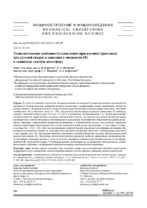| dc.contributor.author | Коротеев, А. О. | |
| dc.contributor.author | Фетисова, Е. А. | |
| dc.contributor.author | Паршин, С. Г. | |
| dc.contributor.author | Коротеева, А. А. | |
| dc.coverage.spatial | Минск | ru |
| dc.date.accessioned | 2024-10-17T12:50:40Z | |
| dc.date.available | 2024-10-17T12:50:40Z | |
| dc.date.issued | 2024 | |
| dc.identifier.citation | Технологические особенности плавления присадочной проволоки при дуговой сварке и наплавке с введением SF6 в защитную газовую атмосферу = Technological Features of Filler Wire Melting for Arc Welding and Surfacing with the Introduction of SF6 into Protective Gas Atmosphere / А. О. Коротеев, Е. А. Фетисова, С. Г. Паршин, А. А. Коротеева // Наука и техника. – 2024. – № 5. – С. 380-389. | ru |
| dc.identifier.uri | https://rep.bntu.by/handle/data/150139 | |
| dc.description.abstract | В статье на основании результатов экспериментальных исследований установлены важные закономерности зависимости частоты коротких замыканий дугового промежутка и коэффициента потерь электродного металла на разбрызгивание от напряжения на дуге и скорости подачи присадочной проволоки при сварке и наплавке с введением газообразного SF6 в защитную смесь Ar + CO2. Предлагается вводить фторсодержащие компоненты SF6 непосредственно в защитную газовую смесь 82 % Ar + 18 % CO2 в количествах, не превышающих 2 %. Технология позволяет снизить количество диффузионного водорода в наплавленном металле, что является актуальной задачей при сварке высокопрочных сталей и материалов, чувствительных к водородному охрупчиванию. Ранее нами был решен ряд вопросов, связанных с препятствием повышения концентрации S в наплавленном металле, что позволило определить наиболее эффективные концентрации SF6 в составе защитной газовой среды, ограниченные 1,5 % по объему от общего состава (Ar + CO2) + SF6. При этом модификация защитной газовой атмосферы галогенидным соединением SF6 оказывает существенное влияние на характеристики плавления электродной проволоки и температурные показатели в зоне горения дуги. Это обусловлено высоким потенциалом ионизации фтора как продукта высокотемпературной реакции диссоциации SF6. Полученные результаты позволили определить наиболее эффективные соотношения между значениями параметров режима, а также исследовать специфику плавления присадочной проволоки в модифицированной SF6 защитной атмосфере. Установлены важные закономерности, раскрывающие технологические особенности сварки и наплавки с модификацией защитной атмосферы галогенидными соединениями. | ru |
| dc.language.iso | ru | ru |
| dc.publisher | БНТУ | ru |
| dc.title | Технологические особенности плавления присадочной проволоки при дуговой сварке и наплавке с введением SF6 в защитную газовую атмосферу | ru |
| dc.title.alternative | Technological Features of Filler Wire Melting for Arc Welding and Surfacing with the Introduction of SF6 into Protective Gas Atmosphere | ru |
| dc.type | Article | ru |
| dc.identifier.doi | 10.21122/2227-1031-2024-23-5-380-389 | |
| local.description.annotation | On the basis of the results of experimental studies the paper establishes important patterns of dependence of the frequency of short circuits of the arc gap and the coefficient of loss of electrode metal due to spatter from the voltage on the arc and the feed rate of the filler wire during welding and surfacing with the introduction of gaseous SF6 into the Ar + CO2 protective mixture. It is proposed to introduce fluorine-containing components of SF6 directly into the protective gas mixture of 82 % Ar + 18 % CO2 in quantities not exceeding 2 %. The technology makes it possible to reduce the amount of diffusion hydrogen in the deposited metal, which is an urgent task when welding high-strength steels and materials sensitive to hydrogen embrittlement. Previously, we resolved a number of issues related to the obstacle to increasing the concentration of S in the deposited metal, which made it possible to determine the most effective concentrations of SF6 in the protective gas environment, limited to 1.5 % by volume of the total composition (Ar + CO2) + SF6. At the same time, modification of the protective gas atmosphere with the halide compound SF6 has a significant effect on the melting characteristics of the electrode wire and temperature indicators in the arc combustion zone. This is due to the high ionization potential of fluorine as a product of the high-temperature dissociation reaction of SF6. The results obtained have made it possible to determine the most effective relationships between the values of the mode parameters, as well as to study the specifics of melting the filler wire in a protective atmosphere modified with SF6. Important regularities have been established that reveal the technological features of welding and surfacing with modification of the protective atmosphere with halide compounds. | ru |

